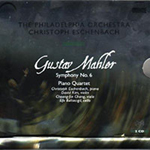This review page is supported in part by the sponsors whose ad banners are displayed below |
 |
 |
|
 |
The M6 isn’t lame in the bass. It simply doesn’t belong in the bone-dry extremely punchy category. What drives music like Nada Surf forward—a high degree of rhythmic taut interplay amongst the ensemble even during uptempo numbers—slightly decelerates with the M6. Here I also recall Nubert’s nuVero 10 as having been quicker.
Time for the classics where the M6 cut a very rakish figure. Particularly smaller ensembles were pure pleasure. Gustav Mahler’s Piano Quintet in A minor with its shifts between the elegiac and passionately incendiary demonstrated how the M6 was plenty quick of response but simply more so in the mid to treble bands. |
|
|
|
|
Sudden violin string plucks, ascending string play, pearlescent piano runs, arpeggios and metallic fortissimo chords all had proper timing without delay which in combination with the tonally gentle yet highly resolved presentation produced— to put it very unscientifically—joy. With classic music the previously noted Nada Surf Gemütlichkeiten in the low bass didn’t disturb me with one bit.
|
 |
Over the last few years I’ve hosted a number of floorstanders of comparable price. These included the already mentioned PSB Synchrony One and Abacus monitor/sub combo, the Nubert nuVero 10 and my work horse, the Neat Momentum 4i. Tasked to name a speaker which mirrors the Swans M6 most closely, I’d still feel rather challenged. The PSB’s bass had more body but the treble was less resolved. The Abacus’ gentler low bass did remind me more of the M6 but was a bit quicker. Treble resolution once again trailed the Swans. The Nubert has legendary image focus and tight quick bass but compared to the Swans can drift into the tonally overly clean or analytical. The Neat’s treble has a clearly higher degree of presence but—hand on heart—no better resolution whilst its stereophonic image lock mirrors that of the Swans. If one adds up these specific aspects, the puzzle combines into a very coherent whole which is commendable for the following:
|
|
|
|
Conclusion: Those beyond their phase of student dorms and musical rebellion plus a bit more space and money could find the Swans M6 to be a friend for the ages. This box plays with enormous detail without becoming tiring, has a very realistic bass balance on the rounder softer side of the fence and a generous dispersion which won't nail you to the sweet spot cross. Once you add exemplary workmanship and quality ingredients, it becomes a mature piece of sonic furniture which is on good speaking terms with nearly all musical styles.
I should add that the M6 can be augmented by matching speakers in the same range (M6 center, rear dipole) to arrive at a dedicated 5.0 solution. There’s even a tweaked slightly differently voiced M6 version. According to the German importer, the Swans RM600 has a bit less bass extension but is tuned for more energetic reflexes [right].
|
|
|
|
 |
Psych profile:
- Treble and upper mids clock in with superb nuance and an ultra-precise rendition of the smallest details yet display a simultaneously mild/friendly temperament which never approaches the hard or bright.
- The transition to the bass is seamless, the bass quality itself more soft and round than taut and brisk. Despite the twin woofers the M6 isn’t bass heavy.
- Soundstaging and image lock are good and typical for the price. Unusual is that the M6 appreciates broader spacing without collapsing center fill or focus.
- Generous off-axis dispersion creates good dimensionality even outside the sweet spot.
- Microdynamics are exceptional, macro dynamics are very good in the upper registers but of a lower order in the bass.
Facts:
- Concept: 3.5-way bass reflex floorstander
- Dimensions and weight: 1085 x 290 x 402mm HxWxD, 34.5kg/ea.
- Trim: Solid Cherry with black front
- Sensitivity: 89dB/2.83V/m
- Nominal impedance
- Warranty: 6 years with returned warranty registration
- Website
|

redaktion @ fairaudio.de
|
 |
 |
 |